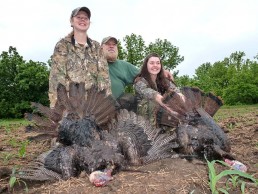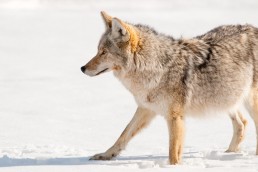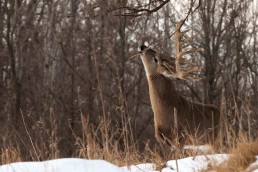Gobbler Calling for Late-Season Success
SHARE THIS POST
When tom turkeys are focused on each other, it does no good to sound like a hen
We’ve turned the page into the month of May, a time of transition in turkey flocks across the Midwest. Depending upon weather and other factors, the switch that flipped in late winter and brought on the mating urge in gobblers gives way to turkeys behaving the way they do the rest of the year. If you don’t pick up on the change, your May hunts will probably be fruitless and frustrating.
The change is not subtle, and when it occurs you have to go back to calling “bird to bird” as I call it, in order to bring gobblers in for a shot. Read this carefully, then watch the video that goes with it, and you’ll see how we made it happen for some young hunters in Kansas last spring, at the end of May.
At the Kansas state JAKES camp (a National Wild Turkey Federation youth program) in fall of 2013, I’d met three young girls who were all hoping to get their first turkey: Madison Lewellen, 14; Jessica Conner, 15; and Tori Lewellen, 12. We planned a hunt for dates that fit everyone’s schedule, at the end of May last spring.
On the evening before our hunt, we took a drive around the hunting area—spots that had been scouted by Gib Rhodes and Brian Lewellen—and I saw everything I needed to see in order to set hunt strategy for the morning. We were watching a group of turkeys out in a big field, and all I saw were gobblers chasing gobblers. They were regrouping and resettling the pecking order.
Gib and Brian knew where these turkeys were roosting, so we set up a blind at a place where the field made a turn and narrowed down. In choosing the setup spot, we violated one of my usual goals: getting as close as possible to the roost. I decided that, even though the gobblers would not want to come all the way across the field, they would if I could get them riled up enough. I didn’t want to put the young hunters too close to the roost for their first morning.
When you watch the video of this hunt, you’ll see how much we bonded and how much fun these girls are—and what a difference it makes when you use gobbler sounds late in the season.
The hunt
It was a rainy day, last week of May, conditions that many turkey hunters would have given up on. We were on the edge of that field from long before daylight until about 11 a.m., and we never heard a hen, never saw a hen. But this was the center of the gobblers’ universe, where it was all happening.
During the hunt, I never once made a hen call. Everything was gobbler calling—gobbler yelping, purring, cutting and gobbling. Because we read the turkeys and adjusted our strategy, we made it happen for these girls.
Here’s the most important thing to learn from this hunt: when gobblers are grouping back up like this, and only paying attention to each other, it does no good to go out in the woods and make hen calls. You might as well blow a goose call if you’re going to sound like a hen. When gobblers are only responding to other gobblers, and settling the pecking order in the flock, you have to sound like a gobbler to get their attention.
When you watch the video, you’ll see this for yourself. We had turkeys chasing other turkeys out of the field, we had turkeys responding to gobbler yelping, gobbling and purring. Because it was so wet, you’ll see the mud build up on the gobblers’ feet as they come to the call.
But best of all, you’ll see Jessica and Madison pull the trigger on a double and the pure excitement they felt on their first hunt. At every seminar I’ve showed that footage to, the crowd starts cheering, like they do when the hero does something to save the day at the movies.
Are you enjoying this post?
You can be among the first to get the latest info on where to go, what to use and how to use it!
And by the way, on the last day of our hunt, the following morning, we made it happen for Tori, too, using exactly this same strategy. Something to keep in mind on your own late-season hunts.
The hunt map
These late-May hunts took place near Madison, Kansas, in the heart of the Flint Hills region. Gib Rhodes and Brian Lewellen, Kansas State JAKES coordinators for NWTF, had told me about three potential roost locations on the evening before the hunt.
We set up a blind at the edge of the big field, on the tip of a point that stuck out, effectively narrowing the field. All three girls were in the blind with me well before daylight, with Gib, Brian and a few others watching from a good vantage point to the west. Loud gobbler yelping on a box call brought gobbling from the distant woods.
Just before sunup, a strutting gobbler came to the calling from the area of the south roost, about 100 yards away. But as the bird was almost to shooting range, a second gobbler entered the field and the pecking order battle took over. A jake also showed up, all three birds chased each other around, and they ended up way down on the east end of the field.
Other gobblers entered the field as well, and I kept picking at them all, using a variety of gobbler sounds. Eventually, the original ‘gang of three’ responded and came marching all the way across the field, mud on their feet. Rain was falling as they made their way into range. The birds came all the way in and were right in front of our blind, and I gave Madison and Jessica the signal to shoot.
Two shots rang out. Two turkeys were flopping on the wet field.
We darn near had a triple, because the jake stood there, still in range. Madison handed off her gun to Tori, but Tori missed and the jake retreated to the east. As it turned out, this only delayed Tori’s success, because she bagged a gobbler in a different spot, using the same strategy, the next morning.
All this action was a direct result of understanding turkey seasonal patterns, recognizing that gobblers were regrouping, and using only gobbler calls. If we had done everything the same but made hen sounds, we would not have been successful.
Ray Eye is a MidWest Outdoors hunting instructor. He was raised in the turkey-rich hills of the Missouri Ozarks, and is considered the dean of America’s professional turkey hunters. It’s less widely known that he is an expert hunter for many other species. Eye has produced an online course, “Calling is Everything,” that details how to call turkeys at any season of the year. Find it at eyesontheoutdoors.com.
MWO
SHARE THIS POST
Did you enjoy this post?
You can be among the first to get the latest info on where to go, what to use and how to use it!
Ray Eye
Ray Eye is an award-winning outdoor communications giant. Eye has a huge following with writing, radio, television and national seminars. This Missouri native is a Missouri Conservation Communicator of the Year, NWTF national Communicator of the Year and was inducted into the “Legends of the Outdoors” National Hall of Fame.



